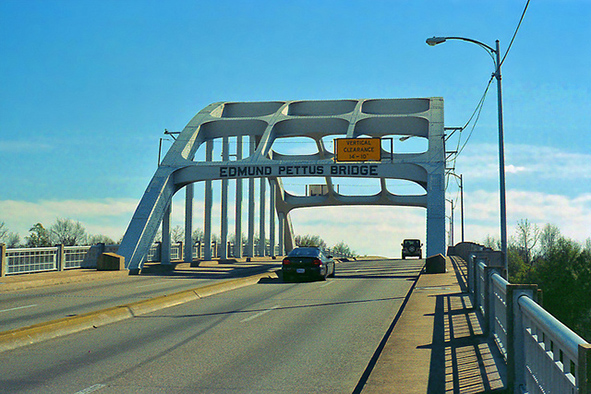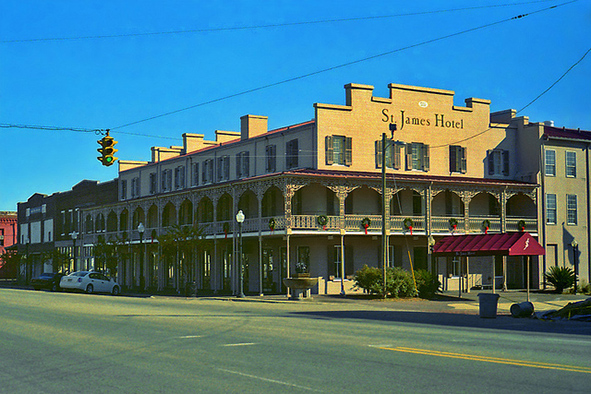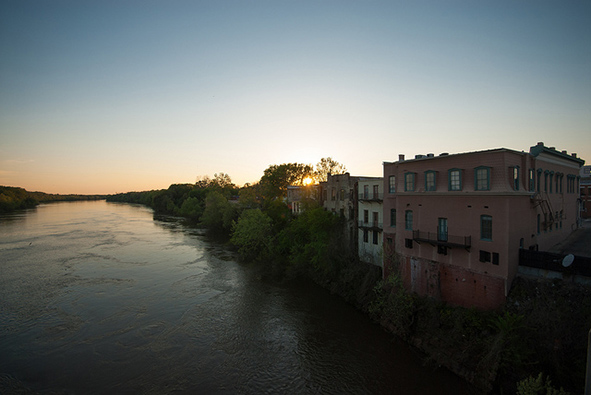Built along the meandering Alabama River lined with dense green trees, Selma is a small town that became the focus of the American Civil Rights movement in 1965. This year, thousands gathered to celebrate a civil rights march that changed a nation.

Edmund Pettus Bridge – a landmark of both Selma and the Civil Rights Movement in America (Photo: Steven Martin via Flickr)
It was a strange thing to be driving down a freeway with no oncoming traffic in the lane opposite us, but it was the 50th anniversary of the Selma to Montgomery March and big things were happening. The road had been cordoned off for President Barack Obama and other U.S. leaders who were, like thousands of other people including my husband and I, descending on Selma.
Frozen in time
Peeking out from rows of trees, dilapidated wooden homes line many streets of Selma’s neighborhoods. Downtown, faded red brick buildings surround the St. James Hotel which was built in 1837. Rumor has it the hotel is haunted by frequent guest Jesse James and his girlfriend, Lucinda. We took a moment to walk through the hotel and I could picture James kicking up his heels in the hotel bar, which has plenty of Southern charm.
That Selma is so unchanged has its good and bad points. It was easy to get a sense of what life was like in Selma during the height of the civil rights movement, and that was the main purpose for our visit.
We knew that thousands of people were expected to arrive the next day for the march’s 50th anniversary. Our first priority was to visit the famous Edmund Pettus Bridge, a white, latticed arching edifice, built in 1940 and showing signs of its age.
Having recently seen the movie “Selma” I still had images in my mind of black marchers being savagely beaten by state troopers using clubs wrapped with barb wire; it was something TV viewers had watched live 50 years ago sparking nationwide outrage.
But the mood on the Edmund Pettus Bridge this day was one of celebration. Hundreds of other people were walking along the bridge too and we talked to some people who had actually participated in the march in 1965.
Origins
The experience on the bridge was something I will never forget. But if we had been more serious about trying to reconstruct the events of the Selma to Montgomery march we should have started at the Brown Chapel AME Church, since that is where the marchers first gathered.
With its two towers and bold white trim it looks just like it did in 1965. It is easy to imagine Martin Luther King Jr. giving his rousing speech prior to the marches because the church still uses the same organ and the pulpit where Dr. King spoke.
Or, even better, we could have visited the Jackson Home first, which has not changed a bit in half a century. This is the home owned by Dr. Sullivan and Richie Jean Sherrod Jackson that was depicted in the movie “Selma”, where Martin Luther King Jr. and other civil rights leaders stayed while they planned the march.
The telephone Dr. King used to speak with President Lyndon Johnson; the chair he sat in; the TV on which he watched President Johnson’s March 15th congressional address are all still there. Johnson’s speech was delivered on the heels of the attack on the civil rights marchers who were demanding the passage of the Voting Rights Act of 1965.
I got to meet Dr. Sullivan and Richie Jean’s daughter, Jawana Jackson. She is a woman who, as a little girl, called Martin Luther King Jr. “Uncle Martin” and remembers him reading her bedtime stories when she was five. She showed me one of the books he read to her, which he had signed for her.
“When I saw it I told him he spelled my name wrong. So he mailed me another copy with the correct spelling,” Jawana recalled.
I found it remarkable that her parents lived in the home for decades afterwards and didn’t change a thing. Since her parents passed, Jawana offers tours of the home and tells guests how there were so many people staying with her family that some people slept in the tub. She also shows them the room where Dr. King and other leaders “booted up” on the day of the march.
Beyond these historic edifices, the National Voting Rights Museum does a great job of filling in the gaps. Their mission, “to preserve the historic journey for the right to vote,” is clearly attained. Between 250,000 and 300,000 people annually visit it to see, among other things, molded cast-iron footprints of some of the marchers, tributes to African-American women and others who helped secure women’s right to vote and a replica of a jail cell where some of the marchers were held.
I talked to National Voting Rights Museum tour guide and historian Sam Walker, who says he enjoys seeing people of all ages, races and creeds pass through town. “People should see the museum because it marks a point, a changing point in our history – and not just black history or America’s history, but the World’s,” Walker said.
Left behind
At the same time there is the discouraging aspect of how little Selma has changed: It is one of the poorest counties in Alabama and that is clear to see. The small businesses downtown look like they are struggling and we were told that there is a real lack of job opportunities in Selma; the local unemployment rate is double the national average.
That is part of what stayed with me. Selma is given so much attention on its historic anniversaries, and many successful people have ties to the city. But when the milestone celebrations are over, people outside of Selma seem to forget about it.
So I have a traveller’s dream: I’d like to imagine that people who have profited from Selma, like the producers of major motion pictures, will push for more development to create more jobs. I’d like to imagine Selma and its long-time residents enjoying not simply what they should have had more than 50 years ago — the right to vote — but a thriving 21st Century economy with ample opportunities for black and white people alike.

